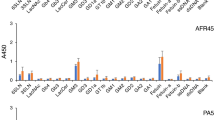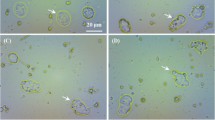Abstract
THE presence of human histocompatibility antigens (HL.A) has been demonstrated on all the human nucleated cells so far studied, but unlike mouse H2 antigens they have not been found on erythrocytes. Harris et al.1, using serological methods, have suggested that they might be present on human reticulocytes. By electron microscopy and an indirect Ferritin labelled antibody technique2, we have studied these antigens at the membrane of bone marrow erythroblasts and erythrocytes. We have observed them on erythroblasts and reticulocytes and their disappearance on mature erythrocytes. Heparinized bone marrow was obtained by sternal aspiration from three subjects, two normal (A Rh+ and O Rh+) and one with mild aplastic anaemia (A Rh+). The supernatant rich in leucocytes was collected after partial sedimentation of erythrocytes. Cells were washed three times in phosphate buffered saline pH 7.2 (PBS) containing 20 per cent foetal calf serum. Aliquots of 5 × 106 cells were incubated for 30 min at 37° C in a 1/3 dilution of an anti-HL.A antiserum, washed three times in PBS, and incubated for a further 30 min at 37° C in ferritin labelled sheep globulin antihuman IgG, prepared as previously described3. After three more washings, cells were fixed with glutaraldehyde postfixed in osmium, dehydrated in alcohol and embedded in Epon. Sections were stained with uranyl acetate and lead acetate4 and examined using a Siemens E IA electron microscope with a magnification of 8,000 to 40,000 times. The anti-HL.A antiserum (provided by Professor J. Dausset) was a highly potent polyspecific anti-HL.A antiserum from a polytransfused patient. It reacted with the lymphocytes of 98 per cent of the French donors in cytotoxic tests up to a dilution of 1/500 to 1/1,000. The donor's blood, being group A, contained natural anti-B antibodies and no other detectable anti-erythrocyte agglutinins. In this respect it was tested against 12 isogroup donors using the immunoferritin technique and never reacted with erythrocytes.
This is a preview of subscription content, access via your institution
Access options
Subscribe to this journal
Receive 51 print issues and online access
$199.00 per year
only $3.90 per issue
Buy this article
- Purchase on Springer Link
- Instant access to full article PDF
Prices may be subject to local taxes which are calculated during checkout
Similar content being viewed by others
References
Harris, R., and Zervas, J. D., Nature, 221, 1062 (1969).
Rifkind, R. A., Hsu, and Morgan, C., J. Hist. Cytochem., 12, 131 (1964).
Silvestre, D., Kourilsky, F. M., Levy, J. P., and Senik, A., CR Acad. Sci., Paris, 268, 1145 (1969).
Reynolds, E. S., J. Cell. Biol., 17, 208 (1963).
Dausset, J., Rapaport, F. T., Barge, A., Hors, J. H., Sasporte, M., and Santana, V., Presse Médicale, 75, 1503 (1967).
Warren, L., and Glick, M. C., J. Cell. Biol., 37, 729 (1968).
Bjaring, B., Klein, G., and Popp, I., Transplantation, 8, 38 (1969).
Author information
Authors and Affiliations
Rights and permissions
About this article
Cite this article
SILVESTRE, D., KOURILSKY, F., NICCOLAI, M. et al. Presence of HL.A Antigens on Human Reticulocytes as demonstrated by Electron Microscopy. Nature 228, 67–68 (1970). https://doi.org/10.1038/228067a0
Received:
Issue Date:
DOI: https://doi.org/10.1038/228067a0
This article is cited by
-
A replication competent Plasmodium falciparum parasite completely attenuated by dual gene deletion
EMBO Molecular Medicine (2024)
-
γδ T cells suppress Plasmodium falciparum blood-stage infection by direct killing and phagocytosis
Nature Immunology (2021)
-
Cytotoxic CD8+ T cells recognize and kill Plasmodium vivax–infected reticulocytes
Nature Medicine (2018)
-
Immunochemical properties of antigens present on immature erythrocytes from mouse and rat
Blut (1981)
-
Antigen Density on Differentiating Erythroid Cells
Nature New Biology (1972)
Comments
By submitting a comment you agree to abide by our Terms and Community Guidelines. If you find something abusive or that does not comply with our terms or guidelines please flag it as inappropriate.



